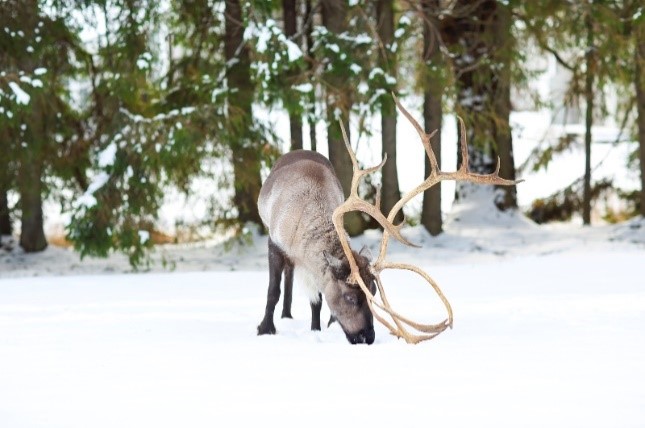
Female radio-collared caribou with group. Photo: Phil Wiebe
Woodland caribou - boreal population (boreal caribou) (Rangifer tarandus caribou) are found in Canada’s boreal forests and the open taiga forests along the Hudson Bay coast.
Unlike caribou that inhabit the tundra, boreal caribou do not migrate long distances between seasons, instead staying in the forest, either alone or in small groups. They need large contiguous areas of suitable habitat with low levels of disturbances.
Boreal caribou consume tree and ground lichens in winter, and lichens, grasses, sedges, forbs, horsetails and shrub leaves in summer. They tend to avoid cleared areas where shrubs favoured by moose and deer are more abundant.
Collaboration in the complex case of the boreal caribou
While provincial and territorial governments finalize range plans for the boreal caribou, diverse groups of Canadians are contributing to caribou management through research and conservation.
Threats to boreal caribou
The main threat to boreal caribou is habitat deterioration, from either fragmentation, degradation or loss. Habitat fragmentation can also contribute to an increase in predation.
Boreal caribou have adapted to an ecosystem in which forest fires are the main type of disturbance. However, human disturbances such as forest harvesting, oil and gas exploration and extraction, and road networks fragment their habitat, creating open areas and extensive young forests that attract species such as moose and deer. This in turn attracts increased numbers of predators, such as wolves.
Climate change is also having an impact on boreal caribou by shifting their geographic distribution. Additional factors impacting caribou include hunting and poaching, noise and light disturbances from resource industry development, parasites and disease.
Species at Risk Act, Recovery Strategy and Action Plan

Boreal caribou are listed as threatened under the federal Species at Risk Act, as well as under provincial legislation in Ontario, British Columbia, Alberta, Manitoba, Labrador, Northwest Territories and Quebec (in French only).
Environment and Climate Change Canada (ECCC) is the federal lead for caribou protection and recovery, as per the Species at Risk Act. ECCC released a Recovery Strategy in 2012 and an Action Plan in 2018.
Natural Resources Canada—Canadian Forest Service (NRCan—CFS) plays a critical role in supporting Pillar 1 of the Action Plan, Knowledge to Support Recovery. NRCan—CFS research informs forest management and habitat restoration standards, and improves predictions about climate change impacts and the future state of caribou critical habitat.
Canadian Forest Service research publications
- Overcoming challenges of sparse telemetry data to estimate caribou movement
- Seismic lines in the boreal and arctic ecosystems of North America: environmental impacts, challenges, and opportunities
- A framework for modeling habitat quality in disturbance-prone areas demonstrated with woodland caribou and wildfire
- More research publications
Canadian Forest Service research projects
- Prioritizing the restoration of fragmented boreal landscapes for caribou protection
- Impact of climate change and forest management practices on caribou habitat in the Canadian boreal forest
- Potential impacts of climate change on boreal caribou habitat
- Assessing the importance of climate change on the distribution of boreal caribou
- Building a centre of excellence in restoration practice